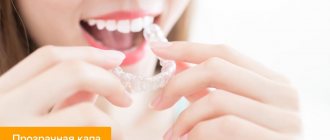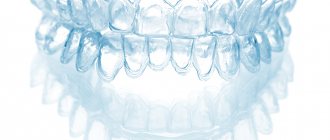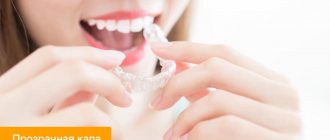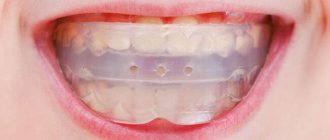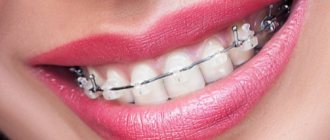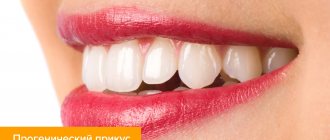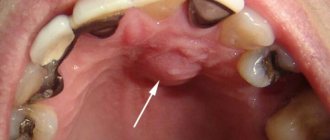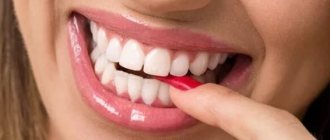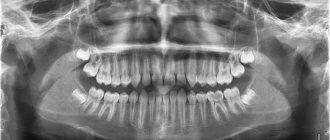home
Orthodontic dentistry
Orthodontic dental treatment
Do you want to have a brilliant smile, but an incorrect bite prevents you from realizing this desire?
Orthodontic dental treatment at the PROFI-Dent clinic will allow you to forget about crooked teeth and malocclusion forever!
You need the help of an orthodontist if you have the following problems:
- crooked teeth;
- constantly worsening periodontitis;
- protruding lower jaw;
- improperly touching dentition;
- protruding upper jaw, due to which the upper lip protrudes all the time.
Only a specialist can accurately determine the correctness of the bite, because quite often an abnormal bite does not appear too clearly visually.
Why does a malocclusion need to be corrected?
Although orthodontic treatment for adults usually takes longer than for children, it is necessary to treat dental defects, because in addition to unaesthetic manifestations, the abnormal structure of the dentition also leads to other problems:
- difficulty chewing food;
- development of bruxism;
- the appearance of pain in the back, neck;
- problems with diction;
- regular headaches, etc.
It doesn’t matter whether you have one crooked tooth sticking out or the entire row of teeth is crooked, modern methods of orthodontic treatment make it possible to quickly get rid of the problem and become the owner of a beautiful smile.
What is modern orthodontics like?
The use of new equipment in orthodontics has significantly improved the quality of treatment. Modern computer technologies make it possible to carry out the most accurate diagnostics, create virtual 3D models of the jaw and manufacture individual orthodontic appliances that will most accurately match the patient’s dental system and the characteristics of malocclusions. In addition, this approach allows you to cooperate with manufacturing companies in any country in the world, sending all patient data in electronic format. Modern orthodontic methods are aimed at simultaneous correction of the entire dentition and individual units to speed up the treatment process. Today, for patients with malocclusion, not only the result of treatment is important, but also the opportunity to continue leading their usual lifestyle with maximum comfort. New orthodontic appliances meet all aesthetic requirements. They have an attractive appearance or are completely invisible on the teeth.
Types of orthodontic treatment
Orthodontists at PROFI-Dent use only the most effective methods of straightening teeth and correcting dentition:
- neat and aesthetic bracket systems (lingual, self-ligating, metal, ceramic, sapphire, etc.);
- comfortable trainers;
- functional mouthguards.
Our doctors will select the most comfortable orthopedic design for you, wearing which will not affect your lifestyle in any way, and the results will not take long to arrive! The price of orthodontic treatment depends on the method used to correct the bite, the complexity of the case, the material and type of dental system, accompanying procedures, etc.
Bite correction systems in dentistry
One of the areas of work of an orthodontist is bite correction. For this purpose:
- Surgical intervention.
If hardware treatment is impossible or ineffective, surgical methods are used. During surgery, the maxillary bone is separated from the skull and placed in the correct position, secured with plates and pins. The lower bone is usually excised, bringing the pieces together using staples. Removing teeth that prevent the jaws from closing properly is also considered a surgical method. - Orthodontic methods.
The main treatment consists of wearing removable and non-removable structures.
Braces
Braces systems are non-removable orthodontic structures. They consist of an arch that exerts pressure on the teeth and plates to which this pressure is transmitted. The material for braces can be ceramic, metal, plastic or sapphire. The plates are fixed to the teeth with dental glue, and they are attached to the arch with micro-locks or elastic bands (ligatures). The archwires are changed regularly to increase pressure on the roots of the teeth to move them into the correct position.
There are braces
- Vestibular
. They are attached to the front surface of the teeth. - Lingual
. Such structures are fixed to the inner surface.
Braces are used for orthodontic bite correction in adults and children over 12 years of age.
. They can be installed for any atypical occlusions, if there are no contraindications.
Braces are not used
for diseases of the blood, bone tissue, tuberculosis, mental disorders.
Relative contraindications would be exacerbation of periodontitis, carious teeth, and tartar. After treatment, installation becomes possible.
Read more: About braces
Aligners (aligners, aligners)
These are removable transparent structures. They are made individually, using impressions, exactly repeating the shape of the tooth. The mouthguards are very thin and you quickly get used to them. They are not noticeable on the teeth, but you need to wear them constantly, day and night, removing them only during meals and hygiene procedures. For complex pathologies, aligners are not used, but if the defect is not very pronounced, it can be corrected without braces. At the same time, the mouthguards do not injure the mucous membrane and dental care is much easier. The cost of correcting a bite with aligners is higher than with braces, but the effect is gentle and they are not visible on the teeth.
Aligners are suitable if the pathology is not too pronounced. For example, when teeth are crowded, when a tooth is out of alignment or if there are large gaps between them.
This method is not used for severe pathologies, tumors, or partial adentia. Relative contraindications for aligners include exacerbations of chronic diseases, periodontitis, weak enamel, and caries. Once the problems are resolved, aligners can be installed.
Read more: About aligners
Training mouthguards (trainers)
Used during the formation of the dentition, usually at night. Trainers apply mechanical pressure on the teeth and train the muscles, eliminating their changes. Trainers are used, most often, to teach a child to swallow food correctly, breathe through the nose and anatomically correctly position the tongue.
In adults, trainers are used to eliminate minor defects and as retainers after treatment with braces.
Records
They consist of a plastic base, a metal arc and fasteners. Plates are prescribed to children to keep the tongue in the correct position, adjust the size of the jaw, and change the width of the palate. Plates are often used to correct mesial malocclusion in childhood. When treating adult patients, it is necessary to resort to surgical intervention, followed by correction with braces.
Removable structures have proven themselves in correcting distal occlusion during the growth period. They slow down the growth of the upper jaw and stimulate the development of the lower jaw. In adults, the main method is braces. Sometimes they are supplemented with a face bow and other devices.
Plates with a bite plane are used to correct deep bites.
Since the plates are used in childhood, they have virtually no contraindications. If there are problems, simply sanitize the oral cavity.
Stages of orthodontic treatment
The process includes the following steps:
Initial examination
Taking impressions of teeth from the upper and lower jaws
Comprehensive diagnostics (orthopantomogram, x-ray)
Selection of the most effective therapy
The main stages of orthodontic treatment with braces:
- Preparing the oral cavity for installation of braces (hygienic cleaning, filling teeth, etc.).
- Installation of bracket system.
- Regular activation of equipment (change of wire arches, ligatures and other devices).
- Removal of braces and installation of a retention device (to consolidate the therapeutic effect).
The PROFI-Dent clinic successfully corrects crooked teeth in patients of any age.
Classification of bites
There are several classifications, but the most common one identifies the following types of bite:
- Neutral
(correct). - Distal.
The upper jaw is pushed forward. The teeth are either tilted forward, not adjacent to the lower jaw, or backward, tightly overlapping it. - Mesial.
The lower jaw protrudes forward. - Cross.
A pathology in which individual teeth in the lower jaw overlap the upper ones is called crossbite. - Open.
With an open bite, the antagonist teeth do not close together. - Deep.
The upper teeth cover half or more of the lower crown. It is interesting that such an anomaly occurs only in modern people; the ancients did not have it.
A - open, B - crossed, C - deep, D - mesial
How much does orthodontic treatment cost?
How much does orthodontic treatment cost?
| Price list for dental | |
| Consultation, initial examination of an orthodontist | 1,000 rubles |
| Diagnostics (taking impressions, study and photoanalysis, calculation) | from 2,800 rubles |
| Full course of treatment with braces (one jaw, payment in stages) | from 60,000 rubles |
| Installation of braces on 1 row of teeth | 15,000 rubles |
| Fixation of a non-removable retainer 1 row of teeth | 5,500 rubles |
| Correction of braces | 3,500 rubles |
| Removing the braces system on 1 row of teeth | 11,000 rubles |
| Metal bracket system | 30,000 rubles |
| Metal self-ligating bracket system | 37,000 rubles |
| Ceramic self-ligating bracket system | 50,000 rubles |
| Ceramic bracket system | 45,000 rubles |
| Orthodontic mouthguard 1 jaw | 5,500 rubles |
Prevention. Why visit an orthodontist?
Dental problems begin at an early age, when a child’s baby teeth just begin to emerge. And often they are problematic due to improper care. The child may develop caries or develop some kind of defect that will develop, but the parents will let it happen due to the fact that “baby teeth will fall out anyway.” But parents must remember that it is necessary to treat baby teeth, since the problem will develop in permanent teeth and bite. Therefore, it is important to properly care for your oral cavity from childhood.
A woman who is just pregnant must take proper care of her health. All food and drinks that the expectant mother consumes affect the development of the child, and it is especially important to constantly maintain the level of fluoride and calcium so that they are at a sufficient level.
Uneven position of teeth and exposure of cervical areas of teeth
Before
Stages
After
In addition to the uneven position of the teeth, the patient’s main complaint was the exposure of the cervical areas of the teeth, the appearance of wedge-shaped defects and, as a result, increased sensitivity. Such nuances appear when the dental system is overloaded due to the lack of correct functional guidance (lack of normal position of the canine, in particular, on the right side). And also in case of incorrect position of the teeth relative to the bone tissue of the jaw.
Based on the results of orthodontic treatment after 18 months, under the control of a computer tomogram, we corrected the position of the roots relative to the bone tissue of the jaws and built a correct occlusal scheme, where the teeth do not experience overload. This work made it possible to reduce the severity of previously existing recessions.
How to choose a doctor?
You need to understand that installing removable appliances to straighten teeth is a complex process that only a professional can carry out. Only a highly qualified specialist who has dealt with anomalies more than once can solve this problem. He will talk about the advantages of this method of treatment, its difficulties, and contraindications. The doctor will discuss suitable devices with the patient. Our dental clinic employs such experienced and qualified specialists.
Reduced chewing efficiency due to lack of a chewing band
Before
Stages
After
Specialists:
Denisova Ekaterina Alexandrovna
The main complaint in this clinical case was reduced chewing efficiency due to the absence of almost the entire chewing group of teeth in the lower jaw.
During the preparatory stage before orthodontic treatment, bridge structures on the upper jaw were removed. The abutment teeth are covered with single composite crowns fixed using an adhesive protocol. The goal of orthodontic treatment was to prepare the dental system for subsequent rational prosthetics, guaranteeing long-term stability of the result. Implantation of missing teeth was carried out at the stage of orthodontic treatment, just like temporary prosthetics. After the braces were removed, all temporary structures were replaced with permanent ones.
Note to parents
How the parents feel about the installation of a removable device determines how the child will feel about this procedure. Adults often make one unforgivable mistake - when they look at the design, surprise appears in their eyes and they ask the question: “How will my child wear this, much less get used to it?” It is clear that after such a reaction, not a single child will want to go to the orthodontist. Therefore, first of all, you need to set yourself up for a positive outcome - high treatment success. This way the child can get used to the device faster.
From the experts
In addition to all the above recommendations, experienced orthodontists offer a number of tips based on practical observations:
- For adults, before installing braces, it is better to remove their wisdom teeth, even if they have not yet erupted, since there is a high risk of them being damaged by caries;
- When choosing a doctor, make sure that the examination is thorough. If the orthodontist suggests putting on braces right away, this is a bad sign. However, another recommendation indicates the low qualifications of the specialist - he suggests waiting to start treatment. Most likely, he does not understand how to solve your problem;
- it is very important to treat all teeth before correcting the bite; in addition, you must learn how to clean them correctly so that while wearing braces the enamel does not become caries;
- Soft tissue adjustments may be required before treatment. You should not be afraid of this; if the doctor suggested performing the procedure, then it is really necessary.
Skeptics believe that correcting a bite in adulthood is useless, and braces are only effective on children’s teeth. This is not a completely correct opinion, but in some ways they are right:
- more significant pressure has to be exerted on the teeth of an adult, which leads to painful sensations at the initial stage;
- some teeth have to be removed to make room for others;
- Bridges and crowns have to be removed during treatment, which also does not add pleasant moments to the procedure.
